David Stairs
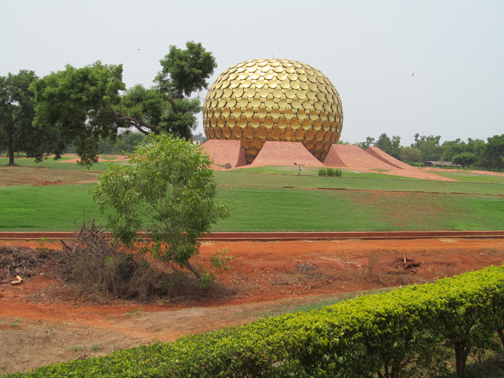
Auroville’s “symbol of the Divine’s answer to man’s aspiration for perfection,” the Matrimandir
Pondicherry, former French colony of India, has an interesting history. Like the former Portugese colony at Goa, now one of the most chic destinations in India, Pondicherry was not a part of British India and, therefore, did not become part of independent India until years after 1947.
Modern Pondicherry, known to Indians as Puducherry, retains some of its Gallic charm. The French maintain a consulate here, and French food is readily available. My West African waiter spoke fluent French. The architecture of old town “Pondy” is reminiscent of New Orleans colonial: streetfront façades, balconies, jalousies and shutters, and interior courtyards.
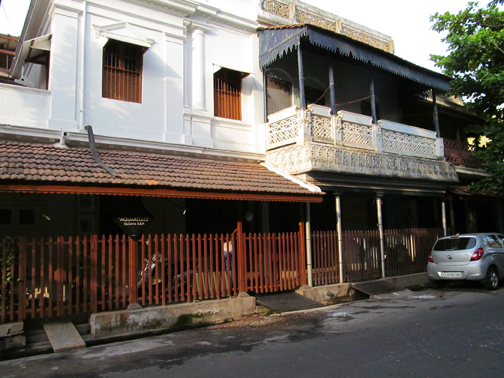
Old French quarter of Pondicherry
I became aware of Pondicherry’s extended colonial history while reading about its most famous former resident, Sri Aurobindo Ghose, who died in French India in 1950. Aurobindo, along with Nehru, Gandhi, and Tagore, was an avid nationalist in the early years of the 20th century. But, after a year’s imprisonment following a bombing he was later acquitted of, the British-educated Aurobindo renounced politics, and in 1910 retired to Pondicherry, eventually founding an ashram there.
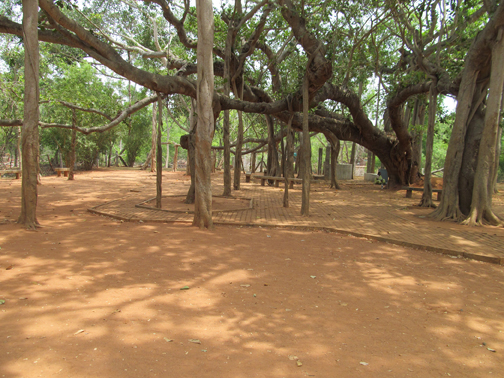
Banyan tree at the center of Auroville
For the next 40 years Aurobindo dedicated himself to writing and spirituality. After his death, his teachings were carried forth by his spiritual partner, Mirra Richard, popularly known as The Mother. In the mid-60’s Richard inaugurated Auroville, an international township endorsed by UNESCO dedicated to human unity. In 1988, by Act of Parliament, the Government of India created the Auroville Foundation recognizing Auroville as an International Cultural Township with special visa status.
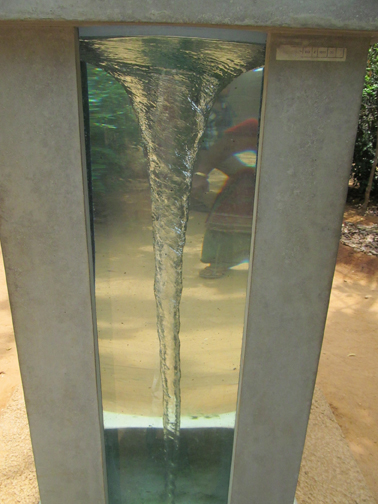
Vortex, an example of dynamized water
Located about 10 kilometers northwest of Pondicherry, Auroville is more than an experiment in human unity. During the 1970’s Auroville was not only the symbolic representation of a spiritual concept, but an early adopter of sustainable best practices. Like Paolo Soleri’s Arcosanti, Auroville is an evolving concept. Although it’s not as dry in Auroville as at Arcosanti, it is incredibly hot. On the day I visited, it was 41°C(103°F) with 90%+ humidity. Water is important, and in India clean water can be the difference between sickness and health. Auroville has installed hundreds of bore holes and dozens of gravity septic systems, as well as a water dynamizing plant.
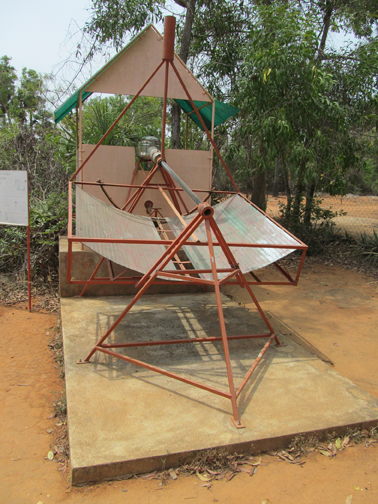
Solar oven display
Auroville was a pioneer of waterless toilets, reclamation of grey water sanitary waste for irrigation, and biogas production. As the sun is Auroville’s most prominent resource, Aurovillians have made good use of it both through solar collectors, and solar ovens. Auroville also exports sustainable technology to communities of the surrounding Tamil-Nadu state, and operates both medical and dental clinics for the surrounding area while researching the application of medicinal plants to human health.
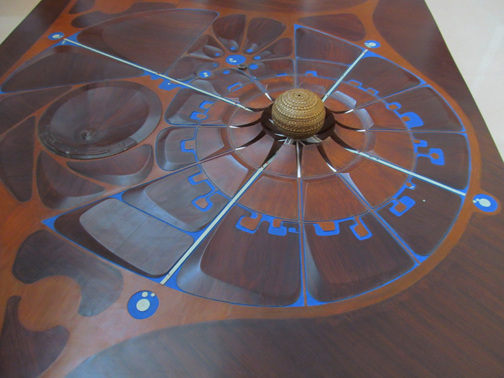
Model of the Matrimandir and its surrounding gardens oriented to the four cardinal points
I’d been led to expect many Western tourists at Auroville, but the majority of people encountered there were Indians. The Matrimandir, or shrine of the Universal Mother, a unity monument containing, at its center, a 70 centimeter crystal globe manufactured in Germany by Zeiss, is a golden geodesic dome plonked down in an earthwork of extra-terrestrial ingenuity. Designed in 1971 by Roger Anger from a sketch by The Mother, and completed over the next thirty years, the dome, comprised of 1415 gold plated discs, emerges from twelve red sandstone “petals” (which double as meditation rooms) like a blooming lotus flower, and is surrounded by gardens. My son’s comment, that “when space aliens arrive they’ll know right where to land” felt more true than ironic. And this cult-like tendency is probably Auroville’s greatest weakness.
Neither an ashram nor a hippie commune, Auroville the peace and unity community, is a step out of time. When it was founded in 1968, and for perhaps a dozen years thereafter, Auroville was a shining beacon of progressive technology wedded to a peace-loving philosophy. Designed in a concentric, car-free “galaxy plan,” Auroville was originally conceived as four zones: industrial, residential, cultural, and international, with the Matrimandir at the center and a green belt surrounding the whole. Like the Nature Conservancy, the Auroville Foundation has attempted to purchase plots of land surrounding its original center, a banyan tree that occupied the site when Anger first visited it. But acquisition of certain strategic plots has proven elusive. To date, only 2000 of its proposed 4000 acres are under Aurovillian custody.
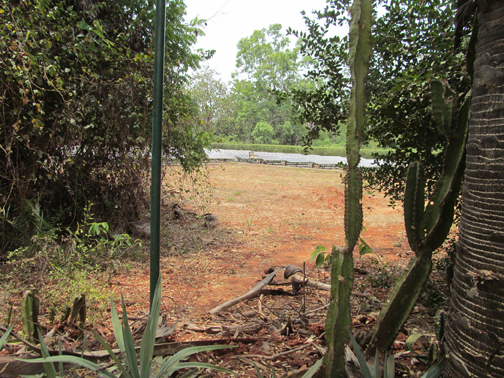
Solar array captures 20kw for use at the Matrimandir
An aura of the 70’s spiritualism clings to Auroville like the lost dream of a 19th century utopian community. The original master plan has been revised several times, and the Government of India has had to intercede in disputes with the Sri Aurobindo Ashram, yet ritual is designed into Auroville at an almost molecular level, with the Matrimandir and its gardens color and numerically coded, and light symbolically manipulated. Originally conceived as a community of 50,000, the current population is 2,100. Recently, the concept of an Industrial Zone has been revised into an economic or enterprise zone after it was conceded that it is cheaper to outsource manufacturing projects to labor rich areas like Pondicherry or Chennai than to bus workers to Auroville.

Plantings and covered walkways line the hot one kilometer path from the Visitor’s Center to the Matrimandir
Self-suffuciency is a wonderful thing and, although it doesn’t own an oil well or manufacture its own vehicles, Auroville is partly self-sufficient in important ways: water management, garden agriculture, energy harvesting, and reforestation. But, whether in the form of a glorified geodesic or through an emphasis on things like solar ovens, Auroville is no longer at the cutting edge of sustainability, regardless of the white papers it has and continues to collaborate on with French and German academics. The world caught up to Auroville, itself never the universal omphalos to any but a tiny minority, and has gone rushing past into the brave new world of a crowd-sourced future.
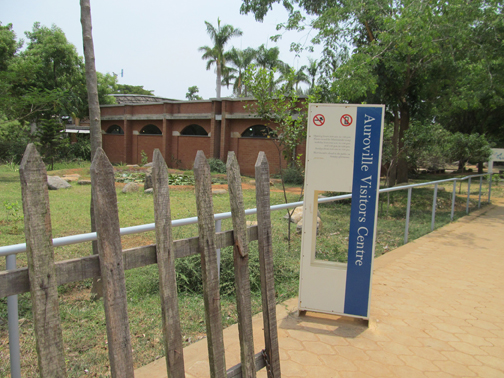
Cafeteria complex and giftshop at left
Perhaps the cafeteria/giftshop complex at Auroville is the most apt metaphor for its future. In these one can find French macrobiotic salads and clever crafts affordably priced. But there’s some question in my mind whether wall calendars with Sri Aurobindo quotations can hope to pay the phone bill, let alone save the world from itself. This is not to say the world doesn’t need examples of peace and unity for our desperate times, only that contemporary times always seem desperate. Whether one avoids the hubbub like Sri Aurobindo did, or wades right into the thick of things, like Nehru, does make a difference. Aurobindo came to Pondicherry and found peace in a quiet escape. India has a long history of such retreats from the world. But for others peace might just as readily be located along a busy urban boulevard as in a sleepy rural throwback to the Age of Aquarius. People living together in peace is an admirable goal. In a capsule interred beneath the amphitheater beside the Matrimandir there is soil from 127 nations. But universal peace requires more than symbolism. Auroville is long on symbolic gestures, but still struggling with the practical implementation of what it means to be a community.
David Stairs is the founding editor of Design-Altruism-Project











Leave a Reply
You must be logged in to post a comment.